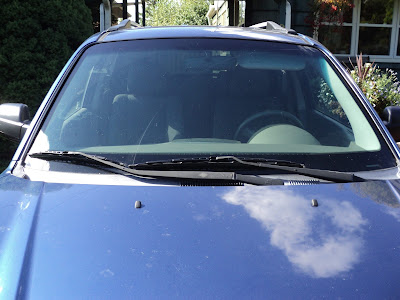My son was in the market for a bench grinder recently, and I advised him against getting a 6" machine. While 6" bench grinders are widely available and not too expensive, I consider them to be borderline toys. The 'hollow grind' effect of an 8" grinder is not so severe, and the linear speed at an 8" wheel's periphery is higher.
My son wasn't too keen on the cost of an 8" bench grinder, but on a recent visit to the USA he happened to pick up one of these from Harbor Freight.
With a coupon, he got it for $39.00 US -- an incredibly low price for an 8" grinder.
Needless to say, though, for a price like that one is not getting a high-end piece of fine machinery. The axial run-out (wobble) of the left side wheel is awful, and the machine runs with a nasty vibration. Just out of curiosity, I'm going to measure axial and radial run-out on both wheels. Then I'll see what, if anything, I can do to correct it.
Axial Run-Out Measurement
Here's my setup for measuring axial run-out at a wheel's periphery.
Axial run-out on that wheel is about 0.060"!
Radial Run-Out Measurement
And here's my setup for measuring radial run-out at the edge of a wheel
Radial run-out on that wheel is about 0.020".
Contributors To Axial Run-Out
First off, for some odd reason, the left side wheel didn't have full labels on its faces -- only the remnants of labels.
I scraped and wire brushed the label fragments to get a reasonably uniform wheel thickness where the flange washers contact the wheel.
The inboard flange washer had axial run-out built into it.
About 0.015". I turned the face of the flange washer to get rid of that.
And finally, the spindle that the inboard flange washer goes on had very little in the way of a shoulder for the flange washer to butt up against, making for an uncertain fit of the inboard flange washer on its spindle.
There's only 0.5mm of a shoulder.
I ended up doing a trial-and-error fit of the whole spindle/flange washers/wheel assembly, experimenting with differing angular relationships of the parts until I got lucky and found the sweet spot where axial run-out was all but gone. I did the same on the right side wheel as well, to good effect.
I dressed the wheels' edges with a diamond dresser; that got the radial run-out to under 0.010"
And that did it. The grinder now runs much, much better.
In Conclusion
For $39.00 US you can get a functioning 8" grinder, but be prepared to put some work into it to get it to run nicely.
The lack of robust spindle shoulders for the inboard flange washers to butt up against is poor design -- one wonders what the manufacturer has for engineering 'talent'.
The toolrests are a bit flimsy, and lack any angular or height adjustability; they're only adjustable for distance from the wheel.
The 3/4 hp rating of the motor looks optimistic to me. (Note that the I.D. label doesn't give an amperage figure.) My hunch is that it's closer to 1/2 hp, but it's quite adequate whatever it is.
For what it's worth, the 3,450 rpm figure is full load speed. No load speed is 3,568 rpm, as measured with a digital photo tachometer.
Not that it's a problem, but just so you know, there's no braking feature. It takes over 3 1/2 minutes for the wheels to coast to a stop after the machine is switched off.
And there we are. As with most of home workshop machinery, 'you pays yer money and you takes yer chances'.
# # #
# # #




















